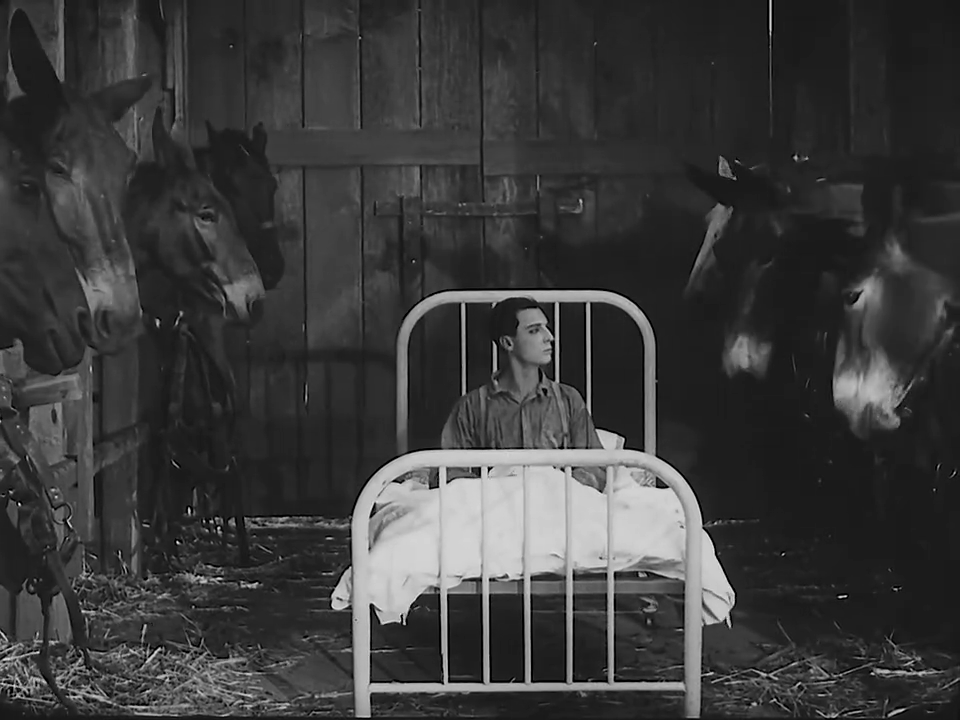A Century of Film is Devin Wilger’s attempt to watch a movie from each year between 1917 and today. This time, it’s 1928, and we’ve got Steamboat Bill Jr.
It’s not intentional when you have two films about the same basic themes coming one after another. Steamboat Bill Jr. is also about fathers and sons taking divergent paths in life, though handled in a much different manner. William Canfield Sr. (Ernest Torrence) is a gruff man of the sea, or at least the river, running an old steamboat called the Stonewall Jackson. When he’s introduced, he’s being harassed by the owner of a newer, fancier steamboat called the King, owned by J. J. King (Tom McGuire). King is the classic rich villain, always trying to keep the working man down. Of course, King has a daughter, Kitty (Marion Byron) and, if the title didn’t clue you in, Canfield has a son (Buster Keaton). And from the moment the two meet in a barber shop, you can see where this is going.
The plot is not why you watch this movie, it’s the name of the last actor. Buster Keaton was, along with Charlie Chaplin and Harold Lloyd, one of the three great silent comedians. Like the other two, Keaton’s gifts were his physical comedy, though his real gift was his ability to avoid reacting. He was known as “the Great Stone Face” and his main skill is that he can avoid reacting to pretty much anything. A complete non reaction to a house falling around you, for example, is something that emphasizes the comedy of the moment - he is capable of being oblivious in the face of events that would make a normal person freak out. Which isn’t to say he’s wooden - he’s actually a pretty great actor, and his mannerisms sell the dandy side of Bill as much as the high fashion costume design does - just that he’s a rare actor who can get a laugh out of doing nothing, as well as a person who can actually do nothing in situations where I can’t imagine even the calmest person avoiding a reaction. The big finale, a hurricane, needs his non-reaction as a way to release tension after the fairly intense action that surrounds it - if he reacted in a way most people would react, there wouldn’t be a pause to take a breath.
The big finale doesn’t take place for a while, and most of the comedy and tension is mined from the contrast between the two Bills. The elder Bill is dirty, rough and strong. The younger is smaller, more fashionable and more delicate. A good portion of the early part of the film surrounds the father trying, and failing, to mold his son into a man like him. This drives a lot of the film, including an early (and ultimately pointless) scene where the younger Bill tries on hats. It doesn’t play as well today, now that fashion has changed and whatever connotations the hats had are lost, but it’s a good way to illustrate the differences between generations - they can’t even understand each other’s hats.
I will confess that the romance isn’t actually very interesting, though that’s at least partially because it’s not given that much time overall. The feud between the fathers is pushed to the foreground - to the point where Keaton’s character feels like a supporting role - and there is a sense of inevitability to this relationship. They have to fall in love to justify the conflict finally resolving in the main story. It still means something when Keaton saves Kitty in the big finale, but strangely enough, it means less than when he saves both his father and hers.
The big finale, however, is easily some of the most spectacular spectacle ever filmed. I mean that even in comparison to modern day films, the sheer amount of destruction is on par with what you might see in an average modern blockbuster. Buildings collapse, fly apart, fall around characters - full size buildings, no less. Wind tosses cars around, throws actors around, and while you’re always kept guessing how they accomplished a lot of the gags, those questions aren’t distracting. There’s room for tiny gags - Keaton does a great bit with a ventriloquist’s doll right in the middle of this - and room for huge ones - a boat drives through a prison. It’s a scene that every modern action filmmaker should watch, because it’s much more exciting than a lot of modern action finales.
The spectacle is part of the reason why the film has aged very well, it’s fantastic to look at even 89 years later. It’s also not something you’re going to see today - no sane insurance underwriter would allow something like this to go ahead, even when Jackie Chan replicated the house stunt he replaced it with a much lighter, though still giant, flower arrangement - good thing too, because it fell on him. It’s a great way to close out the silent era, because it goes out with panache.
Next time, it’s the film commonly regarded as the worst to take home Best Picture at the Academy Awards. Is it actually that bad? We’ll find out when we watch The Broadway Melody.




